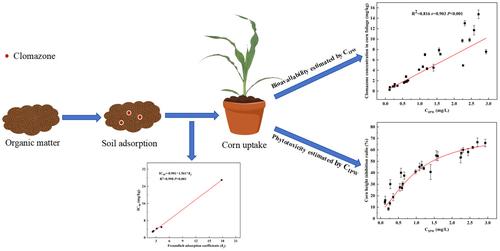当前位置:
X-MOL 学术
›
Pest Manag. Sci.
›
论文详情
Our official English website, www.x-mol.net, welcomes your
feedback! (Note: you will need to create a separate account there.)
Bioavailability and phytotoxicity of clomazone to corn depend on soil characteristics and can be estimated by in situ pore water
Pest Management Science ( IF 3.8 ) Pub Date : 2024-11-08 , DOI: 10.1002/ps.8531 Duantao Cao, Wenwen Peng, Hanghang Xu, Xiaoxiang Fu, Xia Gong, Sumei Yu, Hongyi Wei, Qinghong Zhou, Yingjin Huang
Pest Management Science ( IF 3.8 ) Pub Date : 2024-11-08 , DOI: 10.1002/ps.8531 Duantao Cao, Wenwen Peng, Hanghang Xu, Xiaoxiang Fu, Xia Gong, Sumei Yu, Hongyi Wei, Qinghong Zhou, Yingjin Huang

|
BACKGROUNDThe injury caused by residual herbicides in soils to subsequent crops has been frequently reported and is largely related to soil physicochemical properties. Elucidating the interactions between herbicide toxicity and soil properties could help assess its phytotoxicity based on local soil characteristics. Here, the influence of soil properties on the accumulation and toxicity of clomazone as a model compound to corn was explored to obtain a universal indicator for estimating the toxicity of herbicides against crops.RESULTSThe phytotoxicity of clomazone to corn differed in the five tested soils with the median inhibitory concentration (IC50 ) values, according to the added concentration, fluctuating between 2.80 and 26.97 mg/kg. The uptake of clomazone by corn was primarily affected by its sorption onto soils and showed a positive correlation with the concentration of clomazone in in situ pore water (C IPW ) (R 2 ≥ 0.775, P < 0.001). In contrast to results derived from traditional soil clomazone concentrations (C soil ) determined through organic solvent extraction, consistent IC50 values (1.344–1.626 mg/L) were obtained based on C IPW in all five soils with a much lower coefficient of variation.CONCLUSIONSThese findings indicate that measuring the concentration of clomazone in in situ pore water provides a reliable and comparable method for evaluating its bioavailability and phytotoxicity on corn. Using C IPW rather than C soil as a herbicide indicator is more accurate for assessing its actual phytotoxicity. These results are important for the scientific application of clomazone and the safe production of corn. © 2024 Society of Chemical Industry.
中文翻译:

氯马酮对玉米的生物利用度和植物毒性取决于土壤特性,可以通过原位孔隙水估算
背景土壤中残留除草剂对后续作物造成的伤害经常被报道,这在很大程度上与土壤物理化学特性有关。阐明除草剂毒性与土壤特性之间的相互作用有助于根据当地土壤特性评估其植物毒性。在这里,探讨了土壤特性对氯马酮作为模型化合物对玉米的积累和毒性的影响,以获得估计除草剂对作物毒性的通用指标。结果氯马酮对玉米的植物毒性在抑制浓度中位数 (IC50) 值的 5 种土壤中有所不同,根据添加浓度的不同,在 2.80 至 26.97 mg/kg 之间波动。玉米对氯马酮的吸收主要受其对土壤吸附的影响,并与原位孔隙水 (CIPW) 中氯马酮的浓度呈正相关 (R2 ≥ 0.775,P < 0.001)。与通过有机溶剂萃取测定的传统土壤氯马酮浓度 (Csoil) 得出的结果相比,基于 CIPW 在所有五种土壤中获得了一致的 IC50 值 (1.344–1.626 mg/L),变异系数要低得多。结论研究结果表明,测定原位孔隙水中氯马酮的浓度为评价其对玉米的生物利用度和植物毒性提供了一种可靠且可比的方法。使用 CIPW 而不是 Csoil 作为除草剂指标更准确地评估其实际植物毒性。这些结果对氯马酮的科学应用和玉米的安全生产具有重要意义。© 2024 化工学会.
更新日期:2024-11-08
中文翻译:

氯马酮对玉米的生物利用度和植物毒性取决于土壤特性,可以通过原位孔隙水估算
背景土壤中残留除草剂对后续作物造成的伤害经常被报道,这在很大程度上与土壤物理化学特性有关。阐明除草剂毒性与土壤特性之间的相互作用有助于根据当地土壤特性评估其植物毒性。在这里,探讨了土壤特性对氯马酮作为模型化合物对玉米的积累和毒性的影响,以获得估计除草剂对作物毒性的通用指标。结果氯马酮对玉米的植物毒性在抑制浓度中位数 (IC50) 值的 5 种土壤中有所不同,根据添加浓度的不同,在 2.80 至 26.97 mg/kg 之间波动。玉米对氯马酮的吸收主要受其对土壤吸附的影响,并与原位孔隙水 (CIPW) 中氯马酮的浓度呈正相关 (R2 ≥ 0.775,P < 0.001)。与通过有机溶剂萃取测定的传统土壤氯马酮浓度 (Csoil) 得出的结果相比,基于 CIPW 在所有五种土壤中获得了一致的 IC50 值 (1.344–1.626 mg/L),变异系数要低得多。结论研究结果表明,测定原位孔隙水中氯马酮的浓度为评价其对玉米的生物利用度和植物毒性提供了一种可靠且可比的方法。使用 CIPW 而不是 Csoil 作为除草剂指标更准确地评估其实际植物毒性。这些结果对氯马酮的科学应用和玉米的安全生产具有重要意义。© 2024 化工学会.


















































 京公网安备 11010802027423号
京公网安备 11010802027423号